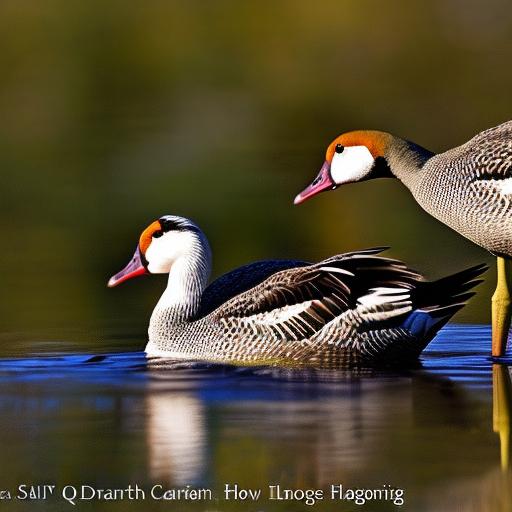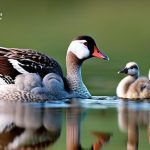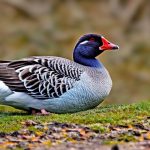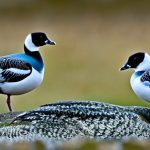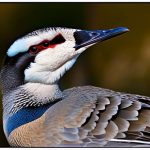Geese are a common sight in ponds, but they can cause problems for property owners and the environment. While they may seem harmless, geese can actually have a negative impact on earth ponds. They can damage pond banks and vegetation, pollute the water with their droppings, and compete with other wildlife for resources. This can lead to a decline in water quality and the overall health of the pond ecosystem. In order to maintain a healthy and balanced pond environment, it is important to find ways to deter geese from nesting and feeding in earth ponds.
Key Takeaways
- Geese can cause problems in ponds by damaging the ecosystem and creating unsanitary conditions.
- Earth ponds provide important benefits for wildlife and ecosystems, making it important to find ways to deter geese from nesting and feeding in them.
- Natural features of earth ponds, such as steep banks and underwater vegetation, can discourage geese from using them.
- Vegetation can also play a role in keeping geese away from earth ponds by providing cover for other wildlife and making it difficult for geese to access the water.
- Maintaining a healthy balance in earth ponds is important for both wildlife and humans, and designing ponds with features that discourage geese can help achieve this goal.
The negative impact of geese on earth ponds
Geese can cause significant damage to earth ponds. Their constant grazing can erode pond banks, leading to soil erosion and potential flooding. This can be especially problematic if the pond is located near residential areas or agricultural land. Additionally, geese can strip vegetation from the pond banks, which can disrupt the natural balance of the ecosystem. Without vegetation, there is less habitat for other aquatic plants and animals, leading to a decline in biodiversity.
Furthermore, geese are known for their copious droppings, which can pollute the water in earth ponds. The high nutrient content in goose droppings can lead to an overgrowth of algae and other aquatic plants, resulting in poor water quality. This can have a negative impact on fish and other aquatic species that rely on clean water for survival. In addition, the presence of geese can lead to increased competition for resources such as food and nesting sites, which can further disrupt the balance of the pond ecosystem.
The benefits of earth ponds for wildlife and ecosystems
Despite the negative impact of geese, earth ponds provide numerous benefits for wildlife and ecosystems. Earth ponds are often home to a variety of aquatic plants and animals, including fish, amphibians, insects, and birds. These ponds provide important habitat for these species, offering shelter, food, and breeding grounds. In addition, earth ponds can help improve water quality by acting as natural filters. The vegetation in and around the pond helps to absorb excess nutrients and pollutants, preventing them from entering the water and improving overall water quality.
Earth ponds also play a crucial role in maintaining biodiversity. They provide a diverse range of habitats, including open water, shallow areas, and submerged vegetation. This variety of habitats supports a wide range of species, contributing to the overall health and resilience of the ecosystem. By creating and maintaining earth ponds, property owners can contribute to the conservation of local wildlife and ecosystems.
How earth ponds deter geese from nesting and feeding
Earth ponds have natural features that make them less attractive to geese. Geese prefer flat, open areas for nesting and feeding, so earth ponds with sloping banks and dense vegetation can be less appealing. The steep banks of earth ponds make it difficult for geese to access the water, discouraging them from nesting or feeding in the area. Additionally, the dense vegetation around the pond can create a barrier that makes it harder for geese to access the water.
The natural features of earth ponds that discourage geese
In addition to steep banks and dense vegetation, there are other natural features of earth ponds that discourage geese from nesting and feeding. Geese prefer open areas where they can have a clear view of their surroundings, allowing them to spot potential predators. Earth ponds often have irregular shapes and contours, with hidden nooks and crannies that make it difficult for geese to have a clear line of sight. This can make them feel vulnerable and less likely to settle in the area.
Furthermore, geese prefer shallow water where they can easily access food sources such as aquatic plants and insects. Earth ponds often have deeper areas that are less accessible to geese, making it more difficult for them to find food. By designing earth ponds with these natural features, property owners can create a less attractive environment for geese.
The role of vegetation in keeping geese away from earth ponds
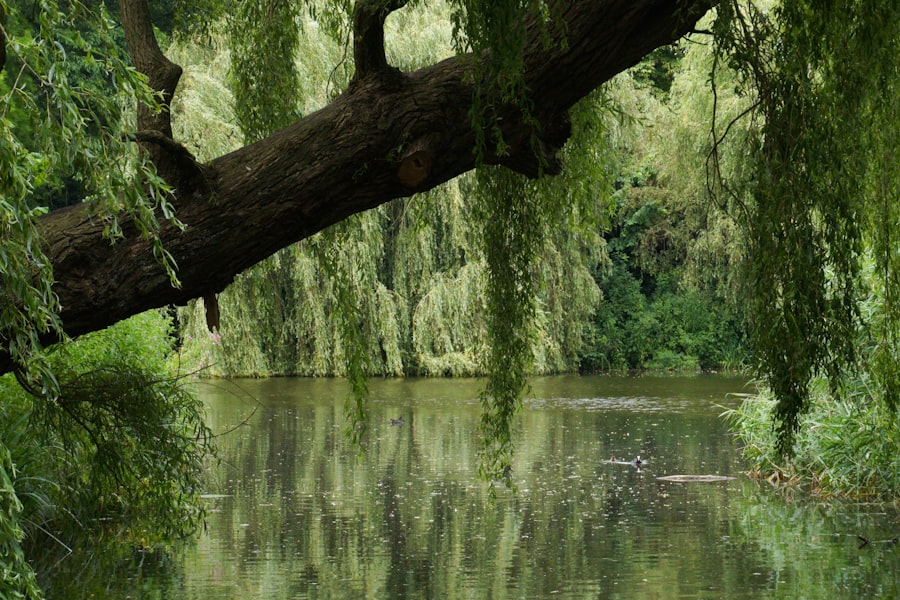
Vegetation plays a crucial role in keeping geese away from earth ponds. Planting tall grasses and shrubs around the pond can create a barrier that makes it harder for geese to access the water. These dense vegetation barriers can make it difficult for geese to see the water and can also make it more difficult for them to navigate through the vegetation. Additionally, planting native species of plants can help attract other wildlife that may prey on geese or compete with them for resources, further discouraging their presence.
It is important to note that not all vegetation is effective in deterring geese. Geese are known to graze on grasses and other low-lying vegetation, so it is important to choose tall grasses and shrubs that are less appealing to geese. Additionally, regular maintenance is necessary to ensure that the vegetation remains dense and healthy. This may include pruning, weeding, and replanting as needed.
The importance of maintaining a healthy balance in earth ponds
In order to deter geese from nesting and feeding in earth ponds, it is important to maintain a healthy balance in the pond ecosystem. Regular maintenance, such as removing excess vegetation and debris, can help keep the pond healthy and discourage geese from settling in. Excess vegetation can provide cover for geese and make it easier for them to access the water. By removing this vegetation, property owners can create a less attractive environment for geese.
It is also important to monitor water quality in earth ponds. Poor water quality can attract geese, as they are attracted to areas with abundant food sources. Regular testing of water quality parameters such as pH, dissolved oxygen levels, and nutrient levels can help identify potential issues and allow for timely intervention. Additionally, maintaining a healthy fish population can help control the growth of algae and other aquatic plants, reducing the availability of food for geese.
How to design earth ponds to reduce the presence of geese
Designing earth ponds with features that deter geese can help reduce their presence. Steep banks can make it difficult for geese to access the water, discouraging them from nesting or feeding in the area. Additionally, creating irregular shapes and contours can make it more difficult for geese to have a clear line of sight, making them feel vulnerable and less likely to settle in the area. Deep water areas can also make it more difficult for geese to find food sources, as they prefer shallow water where they can easily access aquatic plants and insects.
In addition to these natural features, property owners can also consider adding physical barriers to further deter geese. This may include installing fences or netting around the pond to prevent geese from accessing the water. It is important to ensure that these barriers are properly installed and maintained to be effective.
Other methods for managing geese around earth ponds
In addition to designing earth ponds with features that deter geese, there are other methods that can be used to manage geese around earth ponds. One option is to use decoys or scare devices such as noise makers or motion-activated sprinklers. These can help create a sense of danger and make geese feel uncomfortable, discouraging them from settling in the area.
Another option is to use physical barriers such as fences or netting to prevent geese from accessing the pond. This can be especially effective if combined with other deterrent methods. It is important to ensure that these barriers are properly installed and maintained to be effective.
Earth ponds as a sustainable solution for keeping geese off properties
In conclusion, earth ponds can provide a natural and sustainable solution for managing geese around ponds, while also benefiting the environment and other wildlife. By designing earth ponds with features that deter geese, such as steep banks, deep water, and vegetation barriers, property owners can create a less attractive environment for geese to nest and feed. Additionally, regular maintenance and monitoring of water quality can help maintain a healthy balance in the pond ecosystem and discourage geese from settling in. By implementing these strategies, property owners can enjoy the benefits of earth ponds while minimizing the negative impact of geese.
If you’re interested in learning more about how to keep geese off your property, you might also find this article on earth ponds helpful. Earth ponds can be an effective way to deter geese from settling in your area. By creating a natural habitat that is less appealing to geese, you can encourage them to find alternative locations. To learn more about earth ponds and their benefits, check out this informative article: Earth Ponds: A Natural Solution for Keeping Geese Away.
Meet Walter, the feathered-friend fanatic of Florida! Nestled in the sunshine state, Walter struts through life with his feathered companions, clucking his way to happiness. With a coop that’s fancier than a five-star hotel, he’s the Don Juan of the chicken world. When he’s not teaching his hens to do the cha-cha, you’ll find him in a heated debate with his prized rooster, Sir Clucks-a-Lot. Walter’s poultry passion is no yolk; he’s the sunny-side-up guy you never knew you needed in your flock of friends!

